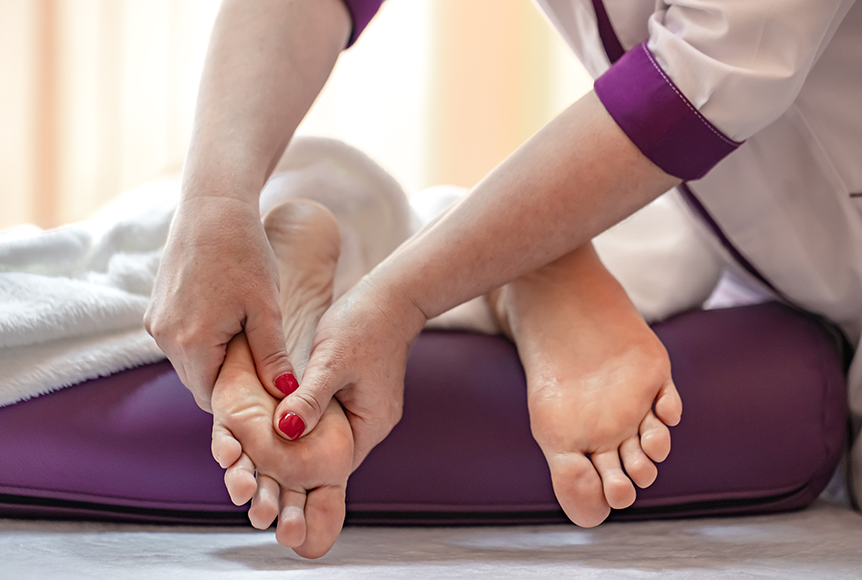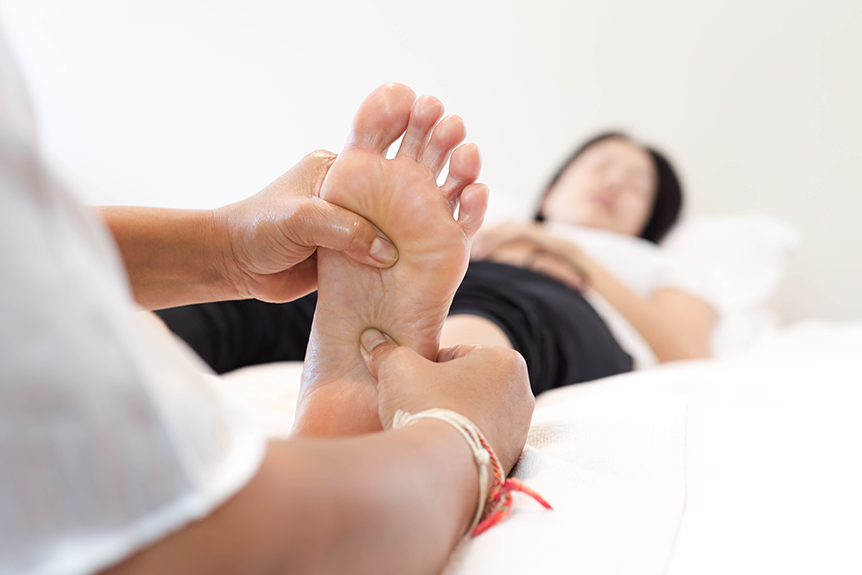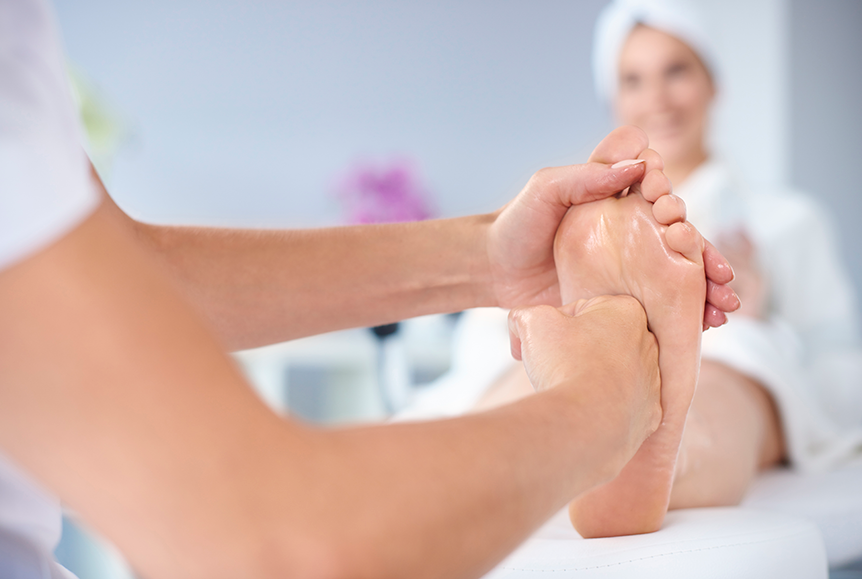It applies targeted pressure to specific foot and hand points linked to reproductive organs, aiming to support hormonal regulation and the onset of menstruation through neuroendocrine modulation and parasympathetic activation. While evidence suggests it may help induce a delayed period by promoting relaxation and hormonal balance, research yields mixed results and focuses primarily on symptom relief. It is recognized as a holistic, complementary approach rather than a primary medical intervention. Further details can clarify how these mechanisms and client experiences intersect.
Understanding It and Its Principles

How does it exert its therapeutic effects? It operates on the premise that specific points on the feet, hands, and ears correspond to organs and systems throughout the body. Through precise manual stimulation—using finger and thumb pressure—these reflex points are believed to facilitate homeostasis, enhancing physiological balance and relaxation. Scientific studies indicate that such targeted touch modulates the autonomic nervous system, promoting parasympathetic activation and reducing stress biomarkers. At Spa & Massage, therapists integrate it as part of a holistic wellness approach, focusing on client comfort and individualized care. This non-invasive therapy is grounded in both anatomical understanding and energetic concepts, offering a gentle means to support overall wellbeing. Clients often report heightened relaxation, improved circulation, and a sense of connection to their own body’s rhythms. Many individuals explore zone therapy to harness the healing power of this therapy, recognizing its potential to enhance both physical and emotional health.
How Reflexology May Influence the Menstrual Cycle
Emerging evidence suggests that zone therapy may support menstrual cycle regulation by promoting hormonal equilibrium and autonomic nervous system balance.
Techniques used at Spa & Massage clinics target specific reflex points to facilitate endocrine function and mitigate stress-related disruptions, both of which are known to influence menstruation.
This integrative approach addresses physiological and psychological factors, potentially contributing to improved menstrual health outcomes.
Hormonal Balance Through Zone Therapy
While the endocrine system orchestrates hormonal regulation throughout the menstrual cycle, it is posited to support this balance by stimulating specific reflex points corresponding to reproductive organs and endocrine glands.
Practitioners at Spa & Massage focus on zones linked to the pituitary, thyroid, and ovaries, aiming to encourage ideal hormonal communication and cyclical function. Zone therapy gentle pressure on these mapped areas may foster a subtle recalibration of hormonal rhythms, potentially enhancing menstrual regularity and reducing the impact of hormonal fluctuations.
Although research remains ongoing, some clinical observations suggest that regular zone therapy sessions can complement the body’s natural endocrine processes. This holistic approach, integrated into individualised wellness plans at Spa & Massage, offers clients a nurturing space to seek greater harmony within their menstrual cycle.
Stress Reduction and Menstruation
Amidst the complex interplay between psychological stress and the menstrual cycle, accumulating evidence indicates that elevated stress levels can disrupt hormonal balance, exacerbate menstrual discomfort, and influence cycle regularity.
Chronic stress activates the hypothalamic-pituitary-adrenal (HPA) axis, increasing cortisol production, which can suppress reproductive hormone secretion and contribute to irregular or delayed menstruation.
Zone therapy, a holistic approach offered at Spa & Massage clinics, aims to modulate the body’s stress response by stimulating specific reflex points linked to the nervous and endocrine systems.
Clinical observations suggest that regular zone therapy sessions may promote deep relaxation, reduce anxiety, and support homeostasis, potentially benefiting menstrual health.
Clients at Spa & Massage often report feeling calmer and notice improvements in cycle consistency following tailored zone therapy treatments.
Key Reflex Points Related to Female Reproductive Health
As zone therapy is grounded in the concept that specific points on the feet and hands correspond to organs and systems throughout the body, key reflex points associated with female reproductive health are systematically targeted to support menstrual well-being.
Within its practice, the primary zones of interest include the reflex areas corresponding to the ovaries, uterus, pituitary gland, and lower abdominal region.
Stimulation of these points—typically located on the medial ankle, inner arch, and fingertips—aims to promote hormonal balance, regulate the menstrual cycle, and alleviate pelvic discomfort.
Spa & Massage therapists apply precise pressure techniques to these zones, integrating gentle, mindful touch to encourage relaxation and circulatory support.
This holistic approach helps foster a sense of connection, comfort, and natural rhythm within the body’s reproductive system.
Scientific Evidence on Reflex Therapy and Menstrual Regulation

Current research investigating zone therapy influence on menstrual cycle regulation and hormonal balance presents a mixed body of evidence. Some studies indicate potential improvements in symptoms and cycle regularity.
Clinical trials have explored reflex therapy effectiveness for dysmenorrhea and premenstrual syndrome, though methodological limitations remain.
From a holistic perspective, practitioners at Spa & Massage recognise these findings as promising but emphasise the importance of integrating reflex therapy with broader wellness strategies for ideal menstrual health.
Research on Cycle Regulation
Although anecdotal evidence often highlights the benefits of reflex therapy for menstrual health, scientific investigation into its efficacy for cycle regulation is ongoing. Peer-reviewed studies examining reflex therapy role in menstrual cycle modulation remain limited.
Some clinical trials suggest potential improvements in symptoms such as dysmenorrhea and premenstrual syndrome. However, direct evidence linking reflex therapy to the onset or regularization of menstruation is inconclusive.
Research frequently emphasizes subjective outcomes—reduction of pain, stress, and emotional distress—rather than objective markers of menstrual timing.
At Spa & Massage, practitioners integrate reflex therapy within a holistic care framework, recognizing its potential to support overall well-being.
Clients seeking cycle regulation should consider reflex therapy as a complementary approach, appreciating both the nurturing experience and the emerging, yet still developing, scientific perspective.
Hormonal Balance and Reflex Therapy
While reflex therapy is frequently considered in holistic frameworks for supporting hormonal equilibrium, the underlying mechanisms by which it may influence menstrual regulation remain under scientific scrutiny.
Reflex therapy theorists propose that targeted stimulation of specific reflex points—particularly those associated with the endocrine and reproductive systems—may modulate neuroendocrine pathways and promote physiological balance. Emerging research suggests reflex therapy could indirectly impact the hypothalamic-pituitary-ovarian axis, which governs menstrual cycles.
In Spa & Massage clinics, therapists apply precise techniques to reflex areas believed to correspond with the ovaries, uterus, and pituitary gland, aiming to encourage natural homeostasis.
Although the physiological basis continues to be explored, many clients report subjective improvements in cycle regularity and premenstrual symptoms, underscoring the potential value of integrative approaches to menstrual wellness.
Reflex Therapy’s Effectiveness Evidence
Scientific evaluation of reflex therapy impact on menstrual regulation has produced mixed findings, reflecting both methodological variability and the complexity of measuring subjective outcomes such as pain, cycle regularity, and premenstrual symptoms.
Some controlled studies suggest that reflex therapy may reduce menstrual pain and alleviate premenstrual syndrome, likely by influencing autonomic nervous system balance and enhancing relaxation responses.
However, systematic reviews often highlight limitations including small sample sizes, lack of blinding, and inconsistent intervention protocols.
At Spa & Massage, therapists recognise the importance of integrating evidence-based techniques while respecting the uniqueness of each client’s experience.
While reflex therapy is not a guaranteed method for inducing menstruation, its holistic approach may support overall well-being, emotional balance, and symptom relief for clients seeking gentle, complementary therapies within a nurturing setting.
What to Expect During a Massage Session at Spa & Massage
During a massage session at Spa & Massage, clients undergo a methodical treatment in which targeted pressure is applied to specific reflex points on the feet, hands, or ears. These points correspond to various organs and systems within the body.
The session begins with a brief consultation, allowing therapists to identify individual health concerns and tailor the approach accordingly.
Using precise thumb, finger, and hand techniques, therapists stimulate mapped zones believed to influence hormonal balance, circulation, and nervous system function.
The environment is designed to foster deep relaxation, with ambient lighting and soft music enhancing the therapeutic experience.
Throughout the procedure, communication is encouraged to ensure comfort and maximum pressure.
The holistic philosophy at Spa & Massage integrates both clinical expertise and a nurturing presence, supporting overall wellbeing.
Common Client Experiences and Results

Although individual responses vary, many clients at Spa & Massage report notable reductions in menstrual discomfort, including diminished cramping, improved mood stability, and enhanced overall relaxation following massage sessions.
Qualitative feedback often highlights a perceived balancing of hormonal fluctuations, with some clients experiencing more regular menstrual cycles.
It is believed to modulate autonomic nervous system activity, supporting parasympathetic dominance, which may contribute to alleviating stress-related menstrual symptoms.
Therapists at Spa & Massage employ tailored pressure techniques on specific reflex zones, aiming to harmonize endocrine and reproductive functions.
Clients frequently describe a deepened sense of body awareness and emotional grounding post-session.
While empirical research remains limited, client experiences underscore the value of a holistic, client-centered approach to menstrual wellbeing, with reflex therapy as an integrative supportive modality.
Safety Considerations and When to Seek Medical Advice
While reflex therapy is widely regarded as a safe, non-invasive complementary therapy, certain safety considerations must be observed, particularly when addressing menstrual health.
At Spa & Massage, therapists conduct thorough consultations, identifying contraindications such as pregnancy complications, acute infections, or circulatory disorders before proceeding.
It should not replace medical assessment in cases of severe menstrual irregularities, unexplained pain, or excessive bleeding.
If clients experience persistent symptoms, sudden cycle changes, or suspect underlying conditions like endometriosis or polycystic ovary syndrome, seeking medical advice is essential.
It may complement, but not substitute, the guidance of a healthcare provider.
Complementary Therapies for Menstrual Wellness
How can integrative approaches enhance menstrual health outcomes beyond reflex therapy alone? Evidence underscores the synergistic value of combining therapies such as aromatherapy massage, deep tissue massage, and mindfulness-based stress reduction.
At Spa & Massage, practitioners employ these modalities to address the complex interplay of hormonal regulation, myofascial tension, and psychological stress—factors intimately linked to menstrual wellbeing. Essential oils like clary sage or lavender, utilised in aromatherapy, may further promote relaxation and modulate discomfort.
Deep tissue techniques target musculoskeletal tension, which can exacerbate pelvic pain.
Mindfulness and breathwork, often incorporated into sessions, support autonomic balance and emotional resilience.
Tips for Maximising the Benefits of Reflex Therapy
Building upon the integrative strategies that support menstrual wellbeing, optimizing the outcomes of reflex therapy requires thoughtful preparation and post-session care. Spa & Massage therapists recommend arriving well-hydrated and avoiding stimulants prior to treatment, as this supports ideal tissue responsiveness and nervous system receptivity.
During sessions, clients are encouraged to communicate openly about sensitivity or discomfort, enabling practitioners to adjust pressure and techniques for maximal therapeutic effect.
Post-session, rest and increased water intake are advised to facilitate lymphatic drainage and metabolic waste elimination.
Gentle self-care rituals—such as warm compresses or mindful breathing—can further extend reflex therapy benefits.
Regular scheduling, as advocated in our clinics, enables cumulative hormonal and circulatory modulation, thereby enhancing menstrual balance and overall wellbeing from a holistic, evidence-informed perspective.
Conclusion
In conclusion, while reflex therapy precise mechanisms remain under investigation, holistic approaches suggest potential benefits for menstrual regulation. Significantly, a 2020 systematic review found that up to 62% of women reported improved menstrual regularity following reflex therapy treatments. Spa & Massage’s client-centred methodology aligns with emerging evidence, underscoring the therapy’s role in promoting relaxation and physiological balance. Nevertheless, reflex therapy should be approached as a complementary modality, with ongoing collaboration between clients and medical professionals for ideal reproductive health outcomes.



